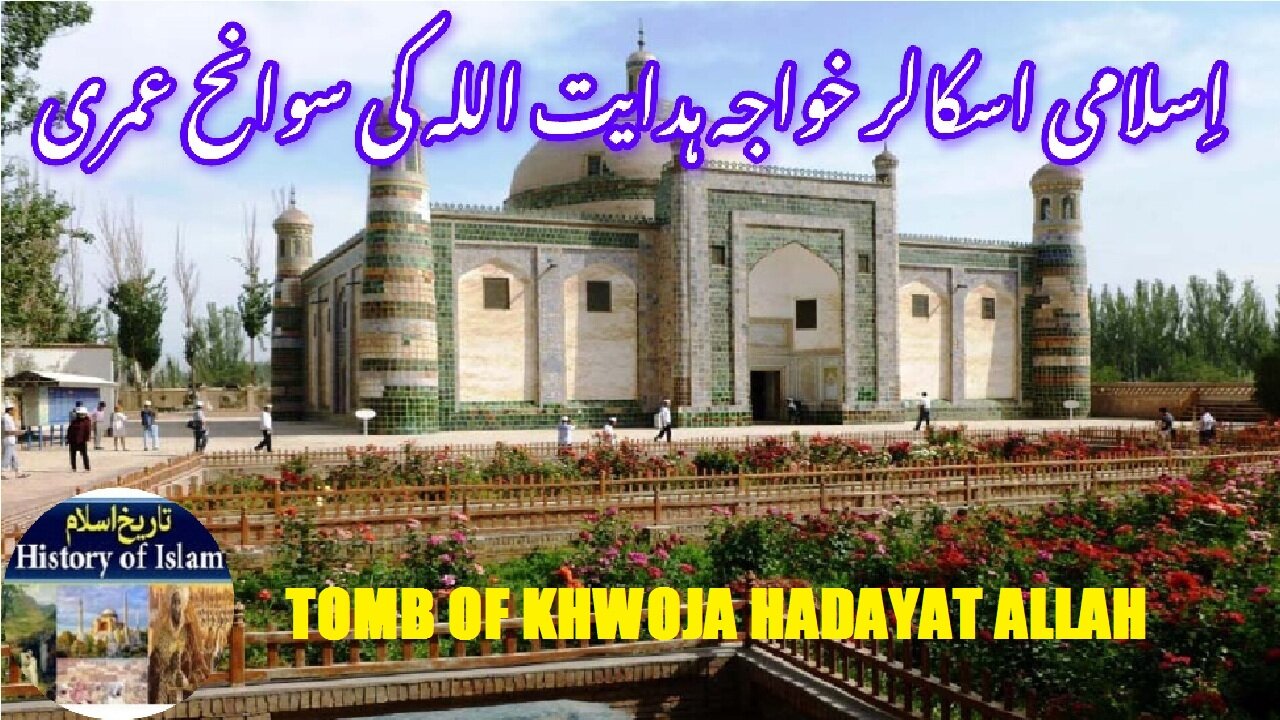Premium Only Content

Biography and tomb of Islamic leader Khwoja Hidayat Allah | خواجہ ہدایت اللہ کی سوانح عمری و مقبرہ
@islamichistroy813 #Biography #Naqashbandi #Leadership #KhwojaHidayatAllah
Biography and tomb of Naqashbandi and political leader Khwoja Hidayat Allah
Dekhti Aankhooon aur sountay kaanoon ko Asslamoalaikum, sisters, brothers friends and elders, In this islamic informative video, we are presenting the biography of Khwoja Hidayat Allah, a distinguished leader within the Naqashbandi tradition and a notable political figure. Through a comprehensive examination of his life, we highlight his spiritual journey, his leadership qualities, and his efforts in advocating for social and political reforms. Get to know the enduring legacy of this influential leader and his contributions to society.
Afaq Khoja was a Naqshbandi and political leader with the title of Khwaja in Kashgaria (in present-day Southern Xinjiang, China). He was also known as Khwoja Hidayat Allah
Under the later Chagatai Khans, Islam recovered from the set-back it had received from the invasions of Chengiz Khan and his immediate successors, thanks mainly to the influence of Bokhara and Samarcand, which had become important centres of Moslem learning. During the reign of Rashid Khan, the celebrated saint Sayyid Khoja Hasan, more generally known as Makhdum-i-Azam or "The Great Master", visited Kashgar from Samarkand and was received with extraordinary honours. The saint's sons settled at Kashgar, where their father had married a wife and had received rich estates, and gradually established a theocracy, laying upon the necks of the submissive, apathetic people a heavy yoke which they still bear. In course of time two parties were formed whose influence on the subsequent history of the country has been profound. The supporters of the elder son were termed Ak Taulin or "White Mountaineers", from the name of the range behind Artush, their headquarters, whereas the supporters of the younger were known as Kara Taulin or "Black Mountaineers", from the hills near Khan Arik. Both parties of Khojas. as they were termed, aimed at political supremacy and intrigued with any external power that appeared likely to favour their ambitions.
Afaq Khoja was a great-grandson of the noted Naqshbandi Sufi teacher, Ahmad Kasani (also known as Makhd?m-i`Azam, "the Great Master") and was revered as a Sufi teacher in his own right. Afaq was born in 1626 in Kumul, where his father Muhammad Yusuf Khoja preached. His mother Zuleiha Begum was the daughter of Mir Sayyid Jalil Kashgari, a rich bek from the village of Bashkerim in the Kashgar Region, who settled in Kumul after fleeing from Kashgar several years previously. In 1638, at the age of 12, he came with his father to Kashgar and settled there. Yarkent Khanate ruler Abdullah Khan (1638–1669) granted his father Bashkerim village and many inhabitants of Kashgar Region became disciples of the Ishkiyya Sufi order, a branch of the Nakshbandi Khojas founded by Muhammad Yusuf Khoja's father Khoja Kalan and whose followers were known as Ak Taghliks or White Mountain Khojas [zh].
Among some Uyghur Muslims, Khoja Appak was considered a sayyid or descendant of Muhammad. As a highly respected religious figure, he was in a clash with ruling elite of the Chagatai (Moghul) dynasty and this conflict had both a religious and secular nature. For the religious part he was an advocator of implementing Islamic Sharia law against Mongol Yassa law which was in force at that time while for the secular part he heavily criticized the luxurious lifestyle which the ruling elites enjoyed. This clash proved serious due to the fact that Chagatai Khan (c. 1185–1241 or 1242) had been appointed by Genghis Khan to see if the Yassa was observed[3] so it eventually resulted in expelling of Afaq Khoja by Ismail Khan (1669, 1670–1678), the later ruler of the Yarkent Khanate. Since the Ishaki Khojas were another offshoot of the Naqshbandi Sufis, Ismail Khan purposefully approached the Ishaki khojas (also known as the Kara Taghliks, i.e. Black Mountain Khojas [zh]) to balance Afaq Khoja influences and prevent dangerous propaganda against him by followers of Afaq Khoja. This clash between religious sects worked to Ismail Khan's advantage. However, the exiled Afaq Khoja had accomplished a diplomatic mission that had led to the collapse of Chagatai (Moghul) dynasty in 1678. In this diplomatic mission Tibet Muslims played a crucial role by convincing the 5th Dalai Lama to write a letter of introduction to the Dzungar Khanate.[4] Using this recommendation letter Afaq Khoja allied with the Dzungars and formed a strong coalition force which included some Chagatai (Moghul) royal family members such as Abdirishit Khan II, Muhammad Imin Khan and Muhammad Momin Akbash, who were against Ismail Khan. Moreover, there were a significant numbers of followers of Afaq Khoja inside the Khanate so that the profile of the Afaq Khoja increased considerably. The Dzungar leader Galdan Boshugtu Khan then launched the Dzungar conquest of Altishahr, conquered the Yarkent Khanate and then installed Afaqi Khoja as one of their puppet rulers.
In 1691 a temporary alliance between Muhammad Imin Khan, son of Sultan Said Baba Khan, who was previously recalled from Turpan and elected as a Khan of the Yarkent Khanate on Kurultai of Kashgar and Yarkent Beks and who was a strong enemy of the Dzungars and Afak Khoja came to an end. Muhammad Imin Khan expelled Khoja from Yarkent and prohibited all inhabitants of Yarkand Khanate to keep any relations with Khoja. In response, Khoja swore to "exterminate all descendants of Chengiz Khan", called his son Yahiya Khoja from Kashgar with troops and attacked Yarkand. Muhammad Imin Khan retreated to Kargalik and from here to the place named Kulagan where a decisive battle took place in 1692 between armies of Khoja and Muhammad Imin Khan. During the battle many supporters of Muhammad Imin Khan deserted him and came to Khoja, that resulted in Khan's defeat. Muhammad Imin Khan fled to the Mountains where he was captured and killed.
Jermon Hall sign in Kasghar
After this victory Afak Khoja declared his son Yahiya Khoja a Khan with the title Khan Khoja and made himself a powerful ruler controlling several cities around the Tarim Basin, including Khotan, Yarkand, Korla, Kucha and Aksu as well as Kashgar. According to sources from Ishaki khojas Afaq Khoja initially paid 100,000 tangas (silver coins) to the Dzungars for their military assistance and accepted the mandate of the Dzungars, led by Galdan Boshughtu Khan (1670–1697). Later the Dzungars demanded they pay them 100,000 tangas every year as tribute and this request was accepted by Afak Khoja.
Afak Khoja died in 1694 and left his son Yahiya Khoja as actual ruler of the Yarkand Khanate (r. 1694–1695). After Yahiya Khoja's death (he was killed by Apak Khoja's wife Khanam Padshah, who was a daughter of Sultan Said Baba Khan, ruler of Turpan and Chalish), Muhammad Mumin Sultan (Akbash Khan, r. 1695–1706) restored the Chagatay (Moghul) dynasty of Yarkand, attempting to get rid of the Dzungar mandate, but finally he fled to India. Kashgaria was soon reconquered by Dzungar Khan Tsewang Rabtan in 1713.
So sisters brothers friends and elders, tomorow we will be described Biography of Sufi Saint Sheikh Noor Ul Mashaikh Sayyid Ahmed Muhiuddin Jeelani. Allah hafiz
====================================
-
 LIVE
LIVE
Adamsgotgame
5 hours agoAim training 357hrs #GZW and more
470 watching -
 LIVE
LIVE
Meisters of Madness
1 hour agoDark Souls 3 - A Campaign Signed in Blood
88 watching -

Candace Show Podcast
4 hours agoJamaica Finally Sent Us Kamala’s Father’s Birth Certificate | Candace Ep 109
25.3K44 -
 24:50
24:50
Misha Petrov
52 minutes agoReacting to YOUR Experiences With Leftist MELTDOWNS Over Trump’s Victory
5 -
 15:33
15:33
Silver Dragons
1 hour agoBullion Dealer Reveals How to Avoid "INFLATION TAX" With Silver and Gold
74 -
 20:53
20:53
SLS - Street League Skateboarding
3 days agoGold Medals, World Class Food, Night life & more - Get Lost: Tokyo
95.2K9 -
 LIVE
LIVE
Yefune Kenizi's [PC] Gaming
4 hours ago $0.62 earnedGTAO - Heists Week: Friday w/ GamingChad
160 watching -
 1:23:02
1:23:02
Baked Linguini's Home Channel
2 hours agoToads Wearing Sunglasses - Let's Play Battletoads in Battlemaniacs
9.44K2 -

Akademiks
6 hours agoDiddy Last Stance! Bail Hearing Live! Lil Durk Case update! Young Thug not getting back his SH*T?
66.3K15 -
 1:03:01
1:03:01
In The Litter Box w/ Jewels & Catturd
22 hours agoLegacy media CANNOT be trusted | In the Litter Box w/ Jewels & Catturd – Ep. 697 – 11/22/2024
47.8K24